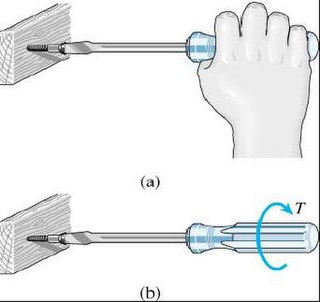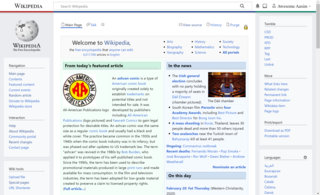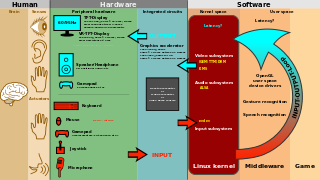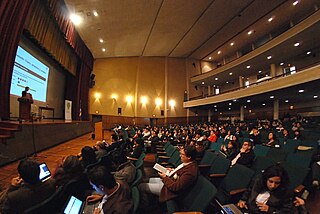 W
WUsability can be described as the capacity of a system to provide a condition for its users to perform the tasks safely, effectively, and efficiently while enjoying the experience. In software engineering, usability is the degree to which a software can be used by specified consumers to achieve quantified objectives with effectiveness, efficiency, and satisfaction in a quantified context of use.
 W
WThe affinity diagram is a business tool used to organize ideas and data. It is one of the Seven Management and Planning Tools. People have been grouping data into groups based on natural relationships for thousands of years; however, the term affinity diagram was devised by Jiro Kawakita in the 1960s and is sometimes referred to as the KJ Method.
 W
WBanner blindness is a phenomenon in web usability where visitors to a website consciously or unconsciously ignore banner-like information, which can also be called ad blindness or banner noise.
 W
WThe word bespoke has evolved from a verb meaning 'to speak for something', to its contemporary usage as an adjective. Originally, the adjective bespoke described tailor-made suits and shoes. Later, it described anything commissioned to a particular specification. Most recently, bespoke has become a general marketing and branding concept implying exclusivity and limited runs.
 W
WExtreme Characters is a methodology used within user-centered design in order to represent edge case users of a product, brand or user interface. Extreme Characters also fits under the umbrella of market segmentation within marketing as it formulates design solutions for both average users and extreme, brink users. The concept of creating extreme users has been adopted heavily into the concept user-centered design and human-centered computing, and has led to its wide adoption both within online and offline applications, along with its placement within marketing communications.
 W
WEye tracking is the process of measuring either the point of gaze or the motion of an eye relative to the head. An eye tracker is a device for measuring eye positions and eye movement. Eye trackers are used in research on the visual system, in psychology, in psycholinguistics, marketing, as an input device for human-computer interaction, and in product design. Eye trackers are also being increasingly used for rehabilitative and assistive applications . There are a number of methods for measuring eye movement. The most popular variant uses video images from which the eye position is extracted. Other methods use search coils or are based on the electrooculogram.
 W
Wf.lux is a cross-platform computer program that adjusts a display's color temperature according to location and time of day, offering functional respite for the eyes. The program is designed to reduce eye strain during night-time use, helping to reduce disruption of sleep patterns.
 W
WA heat map is a data visualization technique that shows magnitude of a phenomenon as color in two dimensions. The variation in color may be by hue or intensity, giving obvious visual cues to the reader about how the phenomenon is clustered or varies over space. There are two fundamentally different categories of heat maps: the cluster heat map and the spatial heat map. In a cluster heat map, magnitudes are laid out into a matrix of fixed cell size whose rows and columns are discrete phenomena and categories, and the sorting of rows and columns is intentional and somewhat arbitrary, with the goal of suggesting clusters or portraying them as discovered via statistical analysis. The size of the cell is arbitrary but large enough to be clearly visible. By contrast, the position of a magnitude in a spatial heat map is forced by the location of the magnitude in that space, and there is no notion of cells; the phenomenon is considered to vary continuously.
 W
WIn software design, the look and feel of a graphical user interface comprises aspects of its design, including elements such as colors, shapes, layout, and typefaces, as well as the behavior of dynamic elements such as buttons, boxes, and menus. The term can also refer to aspects of a non-graphical user interface, as well as to aspects of an API – mostly to parts of an API that are not related to its functional properties. The term is used in reference to both software and websites.
 W
WJakob Nielsen is a Danish web usability consultant. He holds a Ph.D. in human–computer interaction from the Technical University of Denmark in Copenhagen.
 W
WResponsive web design (RWD) is an approach to web design that makes web pages render well on a variety of devices and window or screen sizes. Recent work also considers the viewer proximity as part of the viewing context as an extension for RWD. Content, design and performance are necessary across all devices to ensure usability and satisfaction.
 W
WIn computing, a spatial file manager is a file manager that uses a spatial metaphor to represent files and folders as if they are real physical objects.
 W
WUsability can be described as the capacity of a system to provide a condition for its users to perform the tasks safely, effectively, and efficiently while enjoying the experience. In software engineering, usability is the degree to which a software can be used by specified consumers to achieve quantified objectives with effectiveness, efficiency, and satisfaction in a quantified context of use.
 W
WUser interface (UI) design or user interface engineering is the design of user interfaces for machines and software, such as computers, home appliances, mobile devices, and other electronic devices, with the focus on maximizing usability and the user experience. The goal of user interface design is to make the user's interaction as simple and efficient as possible, in terms of accomplishing user goals.
 W
WEstablished in 2005 by the Usability Professionals Association,, World Usability Day (WUD) or Make Things Easier Day occurs annually to promote the values of usability, usability engineering, user-centered design, universal usability, and every user's responsibility to ask for things that work better. The day adopts a different theme each year. Organizations, groups, or individuals are encouraged to hold events to mark the day, optionally according to that year's theme.